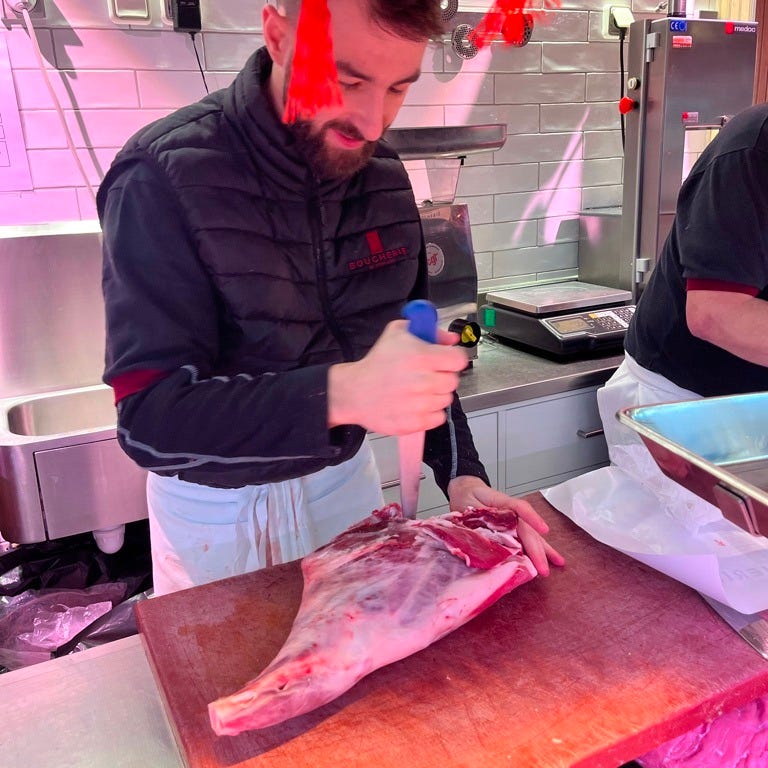Don't Make This Cutting Board Mistake: Wood or No Wood?
Recipe: Roasted Fall Sheet Pan Veggies (perfect for meal prep!)
*This newsletter is not intended to be medical advice. Supported by Mandy Murphy Carroll, RD MPH, Dr. Rosa Keller, PHD RD, Dr. Ricki Pollycove OBGYN, & Dr. Claire Packer OBGYN
Welcome to Modern Women’s Nutrition!
Not only recipes, but the science, stories, and rituals that keep you feeling steady, strong, and alive at every stage of womanhood. With a French twist.
👉🏼 Skip to this week’s recipe, Roasted Fall Sheet Pan Veggies, by clicking here.
So, here’s a strangely specific subject I’ve found fascinatingly controversial over the years in my chef and home-cook world: cutting boards.
This was brought to my attention when we had friends staying at our house a few months ago, and one of them asked my thoughts on wood, since they had just switched to metal.
Metal cutting boards. Oof.
Walk into almost any French kitchen in today’s modern world, and you’ll still see a heavy, scarred, well-loved wooden cutting board holding court on the counter. No plastic, no glass, no metal, no fancy antimicrobial gadgets. Just a hunk of wood.
So simple. So straightforward. So controversial.
In the U.S., there’s a serious cutting board debate raging amongst the people. Is plastic ok? Is bamboo better? Should we all switch to glass, steel, or some futuristic surface recommended by the latest study?
Science isn’t pointing to a clear winner. Plastic and wood can both feed bacteria if they’re neglected. Sure, some studies nudge people toward metal, tempered glass, or titanium. But in a real, working kitchen those options are clunky and brutal on your knives. Which is why the French are loyal to wood. Always.
Knife-friendly. Wood has just enough give to protect the blade, so you’re not constantly sharpening (or replacing) your knives.
Self-healing. Small cuts in the surface close up over time, which prevents bacteria from digging in deep. Wood is alive!
Durable. A good wooden board can last for decades, and even centuries, if you oil and clean it well.
So beautiful. So enjoyable to use. Let’s be real, a wood board just looks and feels so much better.
Like many things (leaving butter on the counter instead of the fridge, having a glass of wine with lunch on a Tuesday) the French don’t overthink their boards. There’s no obsession with sanitizing, no endless swapping between surfaces. They simply trust in a natural material that has been working for centuries.
And it’s not just at home. Walk into any French butcher shop and you’ll see enormous wooden blocks being used all day long for cutting all kinds of meat. The butchers simply wipe them down between orders and keep going.
Again, this is a system that has been working for ages, so why change it now?
A wooden cutting board isn’t just a tool, it’s a kitchen companion. Treat it well and it will serve you for decades, developing that beautiful patina and character you see in every French kitchen. Here’s how to help yours go the distance …
But first, check out this old wooden butcher block transformed into a bar!:
Modern Women's Nutrition is a reader-supported publication — I cannot continue writing without your support. If you enjoy reading, and you find the weekly tips, stories and recipes helpful, consider becoming a paid member for less than the price of a block of cheese per month!
How to Care for Your Cutting Board
Like the French & professional chefs do
Keep reading with a 7-day free trial
Subscribe to Modern Women's Nutrition to keep reading this post and get 7 days of free access to the full post archives.








